2019 HYUNDAI ELANTRA SPORT brake fluid
[x] Cancel search: brake fluidPage 440 of 534
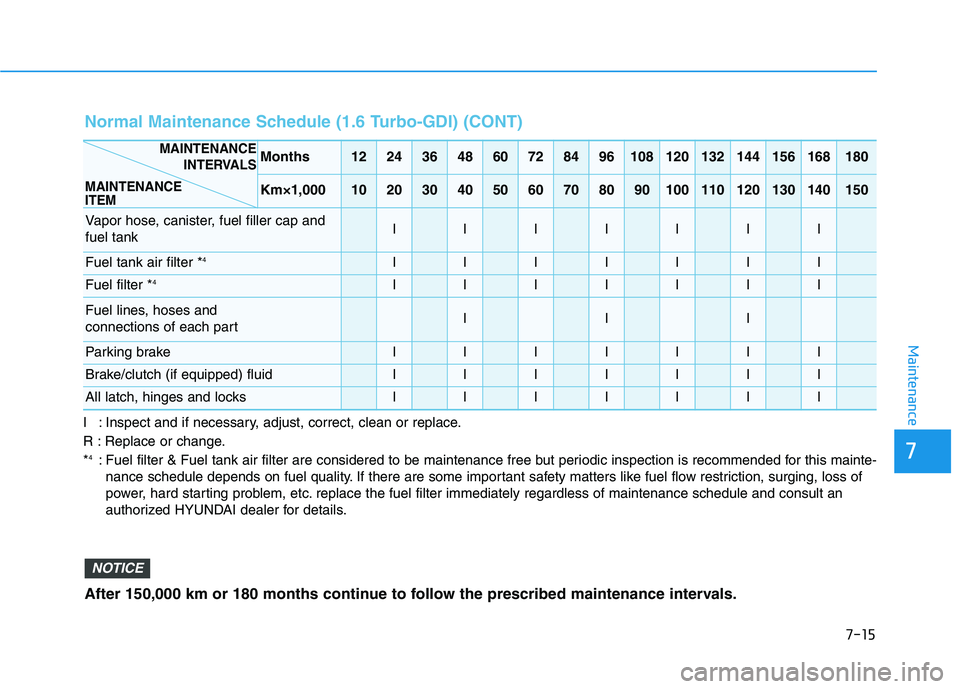
7-15
7
Maintenance
I : Inspect and if necessary, adjust, correct, clean or replace.
R : Replace or change.*4
: Fuel filter & Fuel tank air filter are considered to be maintenance free but periodic inspection is recommended for this maint e-
nance schedule depends on fuel quality. If there are some important safety matters like fuel flow restriction, surging, loss of
power, hard starting problem, etc. replace the fuel filter immediately regardless of maintenance schedule and consult an
authorized HYUNDAI dealer for details.
Normal Maintenance Schedule (1.6 Turbo-GDI) (CONT)
Months1224364860728496108120132144156168180
Km×1,000102030405060708090100110120130140150
Vapor hose, canister, fuel filler cap and fuel tankIIIIIII
Fuel tank air filter * 4IIIIIII
Fuel filter *4IIIIIII
Fuel lines, hoses and
connections of each partIII
Parking brakeIIIIIII
Brake/clutch (if equipped) fluidIIIIIII
All latch, hinges and locks IIIIIII
MAINTENANCE
INTERVALS
MAINTENANCE ITEM
After 150,000 km or 180 months continue to follow the prescribed maintenance intervals.
NOTICE
Page 441 of 534
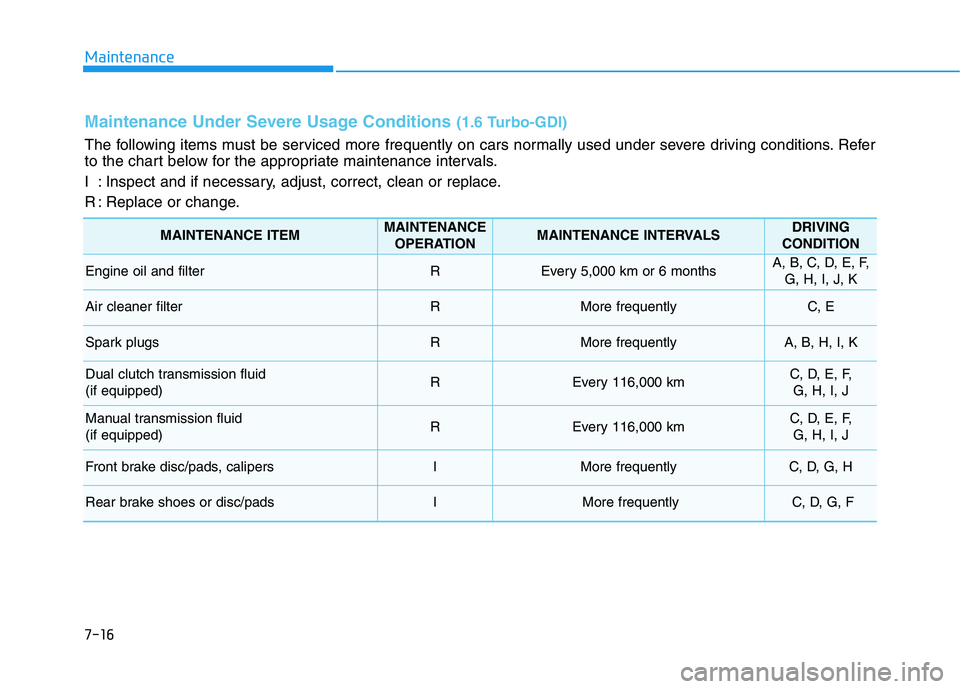
7-16
Maintenance
Maintenance Under Severe Usage Conditions (1.6 Turbo-GDI)
The following items must be serviced more frequently on cars normally used under severe driving conditions. Refer
to the chart below for the appropriate maintenance intervals.
I : Inspect and if necessary, adjust, correct, clean or replace.
R : Replace or change.
MAINTENANCE ITEMMAINTENANCE
OPERATIONMAINTENANCE INTERVALSDRIVING
CONDITION
Engine oil and filterREvery 5,000 km or 6 monthsA, B, C, D, E, F, G, H, I, J, K
Air cleaner filterRMore frequentlyC, E
Spark plugsRMore frequentlyA, B, H, I, K
Dual clutch transmission fluid (if equipped)REvery 116,000 kmC, D, E, F, G, H, I, J
Manual transmission fluid (if equipped)REvery 116,000 kmC, D, E, F, G, H, I, J
Front brake disc/pads, calipersIMore frequentlyC, D, G, H
Rear brake shoes or disc/padsIMore frequentlyC, D, G, F
Page 445 of 534
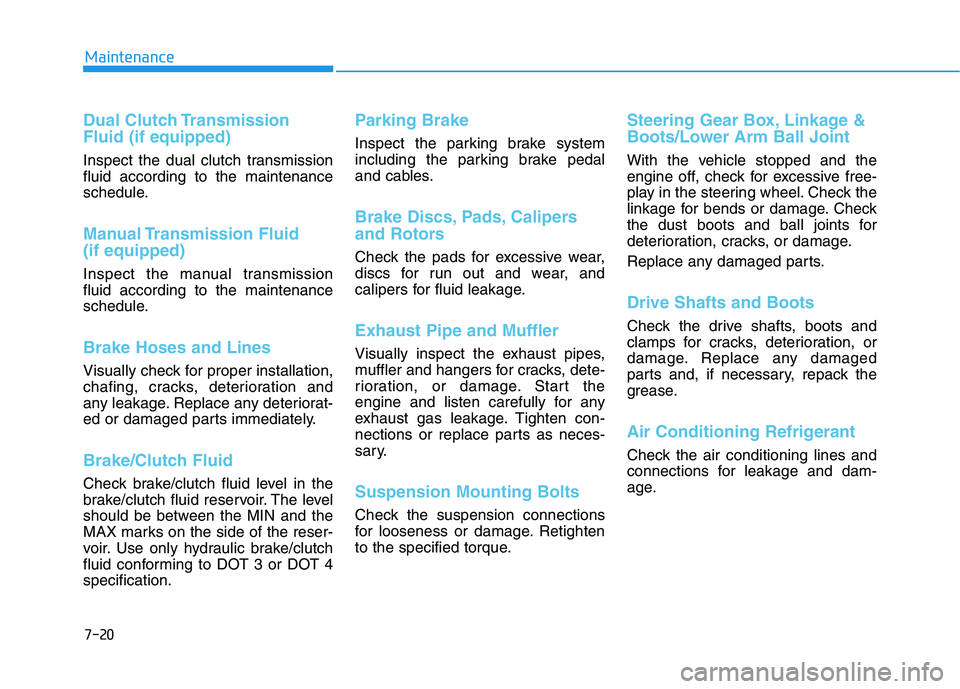
7-20
Maintenance
Dual Clutch Transmission Fluid (if equipped)
Inspect the dual clutch transmission fluid according to the maintenance
schedule.
Manual Transmission Fluid (if equipped)
Inspect the manual transmission fluid according to the maintenance
schedule.
Brake Hoses and Lines
Visually check for proper installation,
chafing, cracks, deterioration and
any leakage. Replace any deteriorat-
ed or damaged parts immediately.
Brake/Clutch Fluid
Check brake/clutch fluid level in the
brake/clutch fluid reservoir. The level
should be between the MIN and the
MAX marks on the side of the reser-
voir. Use only hydraulic brake/clutch
fluid conforming to DOT 3 or DOT 4specification.
Parking Brake
Inspect the parking brake system
including the parking brake pedal
and cables.
Brake Discs, Pads, Calipers
and Rotors
Check the pads for excessive wear,
discs for run out and wear, and
calipers for fluid leakage.
Exhaust Pipe and Muffler
Visually inspect the exhaust pipes,
muffler and hangers for cracks, dete-
rioration, or damage. Start the
engine and listen carefully for any
exhaust gas leakage. Tighten con-
nections or replace parts as neces-
sary.
Suspension Mounting Bolts
Check the suspension connections
for looseness or damage. Retighten
to the specified torque.
Steering Gear Box, Linkage &
Boots/Lower Arm Ball Joint
With the vehicle stopped and the
engine off, check for excessive free-
play in the steering wheel. Check the
linkage for bends or damage. Check
the dust boots and ball joints for
deterioration, cracks, or damage.
Replace any damaged parts.
Drive Shafts and Boots
Check the drive shafts, boots and
clamps for cracks, deterioration, or
damage. Replace any damaged
parts and, if necessary, repack the
grease.
Air Conditioning Refrigerant
Check the air conditioning lines and
connections for leakage and dam-
age.
Page 452 of 534
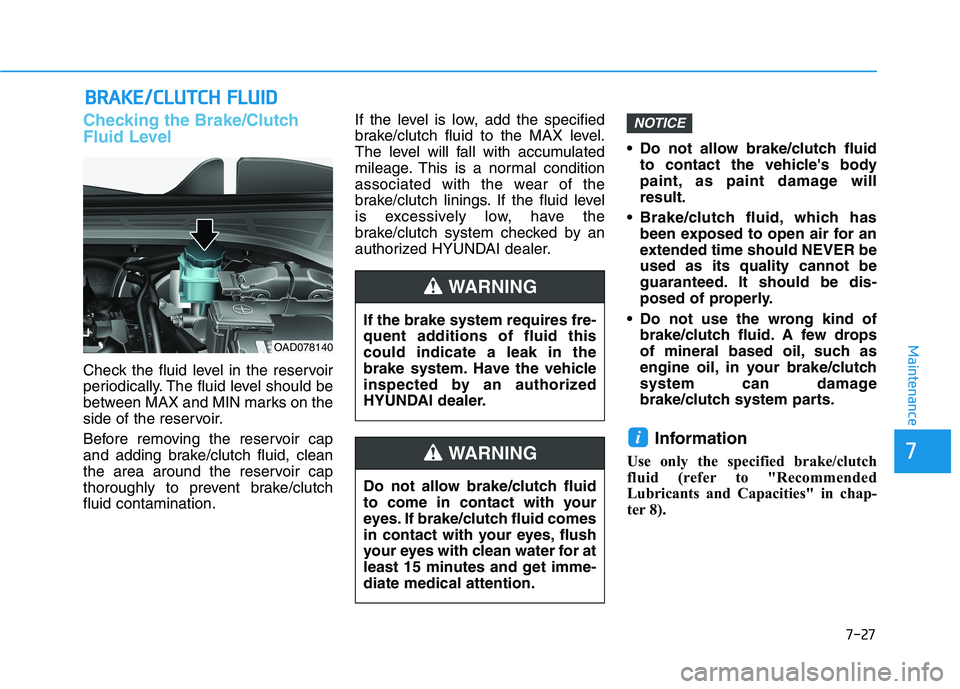
BBRRAA KKEE//CC LLUU TTCCHH FF LLUU IIDD
Checking the Brake/Clutch
Fluid Level
Check the fluid level in the reservoir
periodically. The fluid level should be
between MAX and MIN marks on the
side of the reservoir.
Before removing the reservoir cap
and adding brake/clutch fluid, clean
the area around the reservoir cap
thoroughly to prevent brake/clutchfluid contamination. If the level is low, add the specified
brake/clutch fluid to the MAX level.
The level will fall with accumulated
mileage. This is a normal condition
associated with the wear of the
brake/clutch linings. If the fluid level
is excessively low, have the
brake/clutch system checked by an
authorized HYUNDAI dealer.
Do not allow brake/clutch fluid
to contact the vehicle's body
paint, as paint damage willresult.
Brake/clutch fluid, which has been exposed to open air for an
extended time should NEVER beused as its quality cannot be
guaranteed. It should be dis-
posed of properly.
Do not use the wrong kind of brake/clutch fluid. A few drops
of mineral based oil, such as
engine oil, in your brake/clutch
system can damage
brake/clutch system parts.
Information
Use only the specified brake/clutch
fluid (refer to "Recommended
Lubricants and Capacities" in chap-
ter 8).
i
NOTICE
7-27
7
Maintenance
If the brake system requires fre-
quent additions of fluid thiscould indicate a leak in the
brake system. Have the vehicle
inspected by an authorized
HYUNDAI dealer.
WARNING
Do not allow brake/clutch fluid
to come in contact with your
eyes. If brake/clutch fluid comes
in contact with your eyes, flush
your eyes with clean water for at
least 15 minutes and get imme-diate medical attention.
WARNING
OAD078140
Page 453 of 534
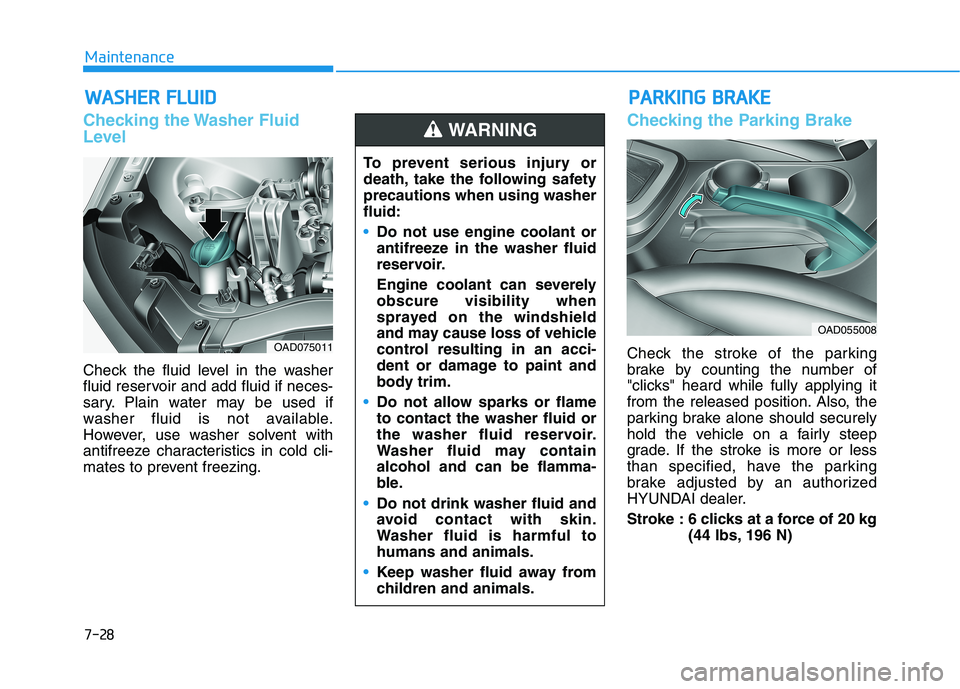
7-28
MaintenanceW
W AASSHH EERR FF LLUU IIDD
Checking the Washer Fluid
Level
Check the fluid level in the washer
fluid reservoir and add fluid if neces-
sary. Plain water may be used if
washer fluid is not available.
However, use washer solvent with
antifreeze characteristics in cold cli-
mates to prevent freezing.
Checking the Parking Brake
Check the stroke of the parking
brake by counting the number of
"clicks" heard while fully applying it
from the released position. Also, the
parking brake alone should securely
hold the vehicle on a fairly steep
grade. If the stroke is more or less
than specified, have the parking
brake adjusted by an authorized
HYUNDAI dealer.
Stroke : 6 clicks at a force of 20 kg
(44 lbs, 196 N)
To prevent serious injury or
death, take the following safetyprecautions when using washerfluid:
Do not use engine coolant or
antifreeze in the washer fluid
reservoir.
Engine coolant can severely obscure visibility when
sprayed on the windshield
and may cause loss of vehicle
control resulting in an acci-
dent or damage to paint and
body trim.
Do not allow sparks or flame to contact the washer fluid or
the washer fluid reservoir.
Washer fluid may containalcohol and can be flamma-
ble.
Do not drink washer fluid and
avoid contact with skin.
Washer fluid is harmful tohumans and animals.
Keep washer fluid away from
children and animals.
WARNING
OAD075011
PP
AA RRKK IINN GG BB RRAA KKEE
OAD055008
Page 520 of 534
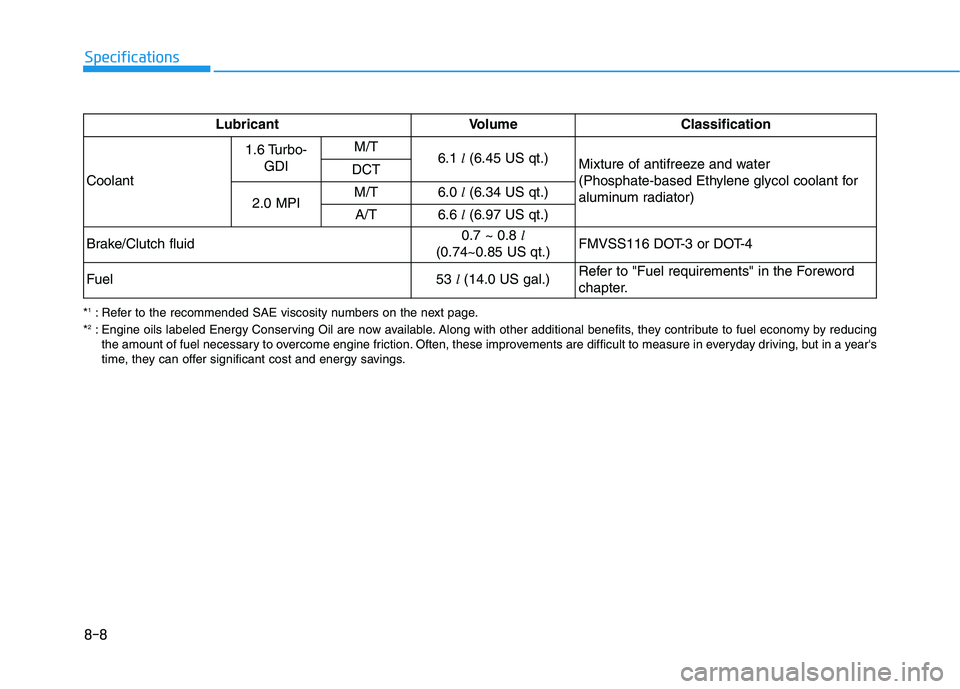
8-8
Specifications
*1
: Refer to the recommended SAE viscosity numbers on the next page.
* 2
: Engine oils labeled Energy Conserving Oil are now available. Along with other additional benefits, they contribute to fuel economy by reducing
the amount of fuel necessary to overcome engine friction. Often, these improvements are difficult to measure in everyday driving, but in a year's
time, they can offer significant cost and energy savings. Lubricant
Volume Classification
Coolant 1.6 Turbo-
GDI M/T
6.1
l(6.45 US qt.)
Mixture of antifreeze and water
(Phosphate-based Ethylene glycol coolant for
aluminum radiator)
DCT
2.0 MPI M/T
6.0
l(6.34 US qt.)
A/T
6.6 l(6.97 US qt.)
Brake/Clutch fluid
0.7 ~ 0.8 l
(0.74~0.85 US qt.) FMVSS116 DOT-3 or DOT-4
Fuel53
l(14.0 US gal.)Refer to "Fuel requirements" in the Foreword
chapter.
Page 526 of 534
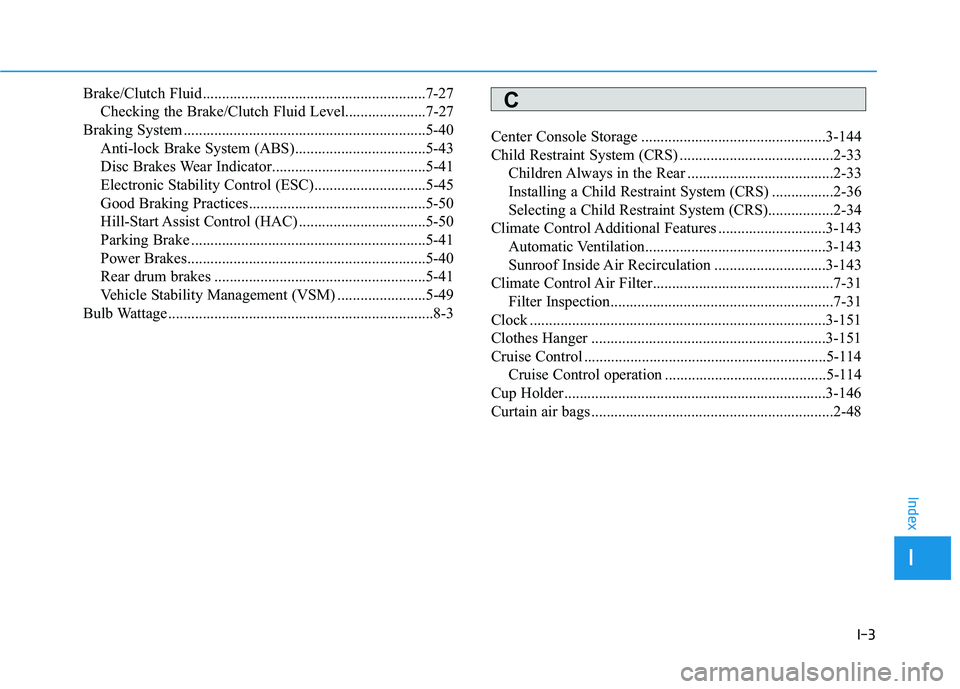
I-3
Brake/Clutch Fluid..........................................................7-27
Checking the Brake/Clutch Fluid Level.....................7-27
Braking System ...............................................................5-40
Anti-lock Brake System (ABS)..................................5-43
Disc Brakes Wear Indicator........................................5-41
Electronic Stability Control (ESC).............................5-45
Good Braking Practices..............................................5-50
Hill-Start Assist Control (HAC) .................................5-50
Parking Brake .............................................................5-41
Power Brakes..............................................................5-40
Rear drum brakes .......................................................5-41
Vehicle Stability Management (VSM) .......................5-49
Bulb Wattage .....................................................................8-3 Center Console Storage ................................................3-144
Child Restraint System (CRS) ........................................2-33
Children Always in the Rear ......................................2-33
Installing a Child Restraint System (CRS) ................2-36
Selecting a Child Restraint System (CRS).................2-34
Climate Control Additional Features ............................3-143
Automatic Ventilation...............................................3-143
Sunroof Inside Air Recirculation .............................3-143
Climate Control Air Filter...............................................7-31 Filter Inspection..........................................................7-31
Clock .............................................................................3-151
Clothes Hanger .............................................................3-151
Cruise Control ...............................................................5-114 Cruise Control operation ..........................................5-114
Cup Holder....................................................................3-146
Curtain air bags ...............................................................2-48
I
Index
C